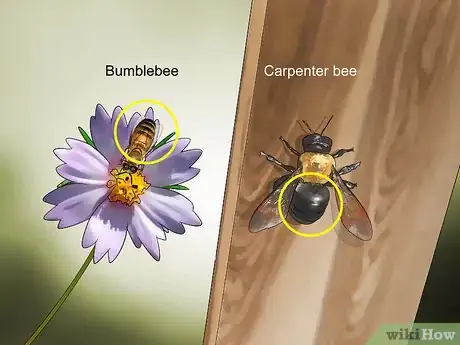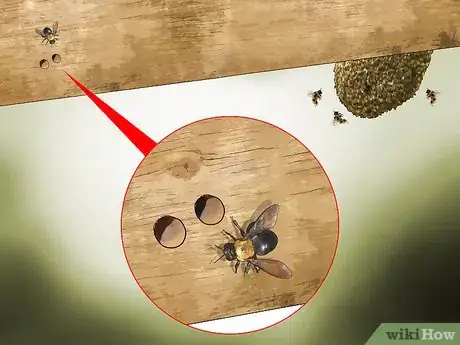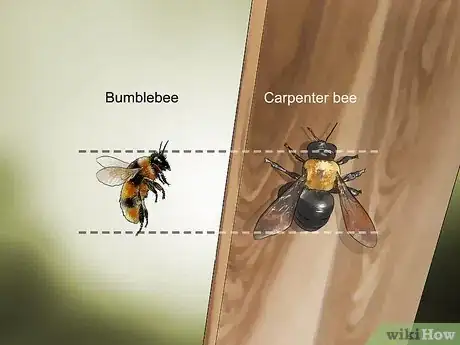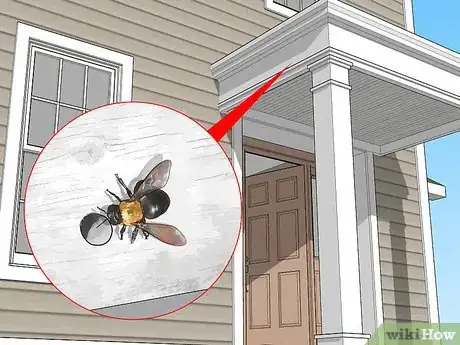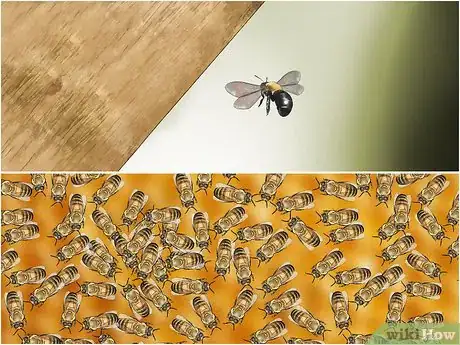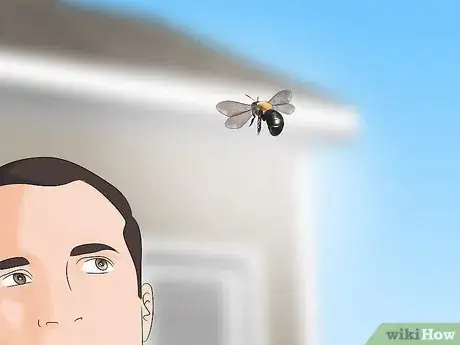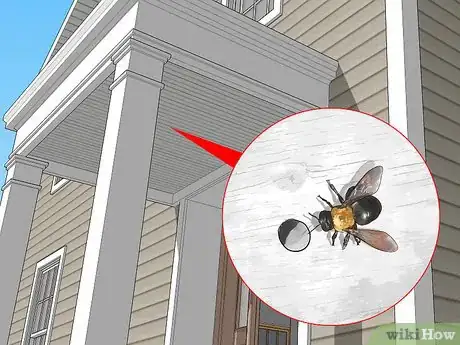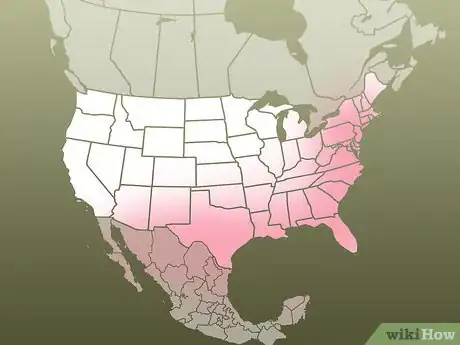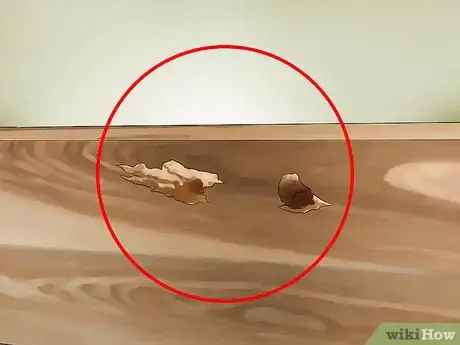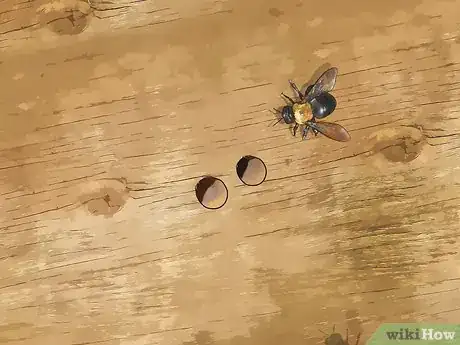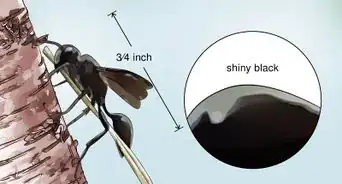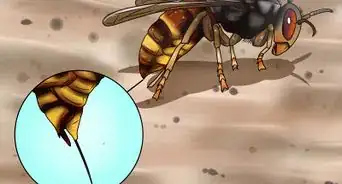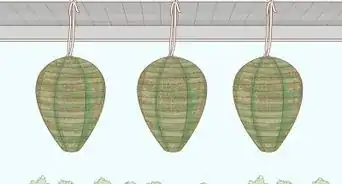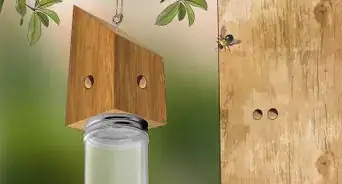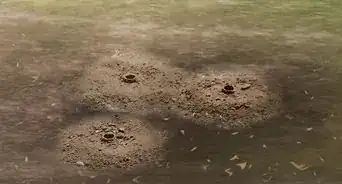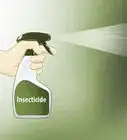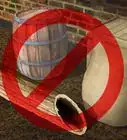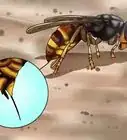This article was co-authored by Scott McCombe. Scott McCombe is the CEO of Summit Environmental Solutions (SES), a family-owned local pest solutions, animal control, and home insulation company based in Northern Virginia. Founded in 1991, SES has an A+ rating with the Better Business Bureau and has been awarded “Top Rated Professional,” and “Elite Service Award" by HomeAdvisor.
There are 15 references cited in this article, which can be found at the bottom of the page.
This article has been viewed 98,032 times.
Carpenter bees are large, black and yellow insects which closely mirror bumblebees. Despite their physical resemblance, however, their behavior is completely different. While bumblebees can sting but are otherwise harmless, carpenter bees sting but can damage wooden structures. Keep an eye out for distinctive features of carpenter bees and wood damage so you can nip infestations in the bud before they get out of control.
Steps
Comparing Carpenter Bees to Bumblebees
-
1Check for a stinger. Unlike male bumblebees, male carpenter bees lack a stinger. They may attempt to attack both humans and other insects, but they are usually harmless. Female carpenter bees do have a stinger but have a docile temperament. Unless directly handled, female bees will not often sting.[1]
- Because female carpenter bees burrow into the wood, you will mostly come in contact with male bees.
-
2Look for a black abdomen without fuzz.[2] Both carpenter bees and bumblebees are large, intimidating insects with black and yellow markings. But bumblebee abdomens are much fuzzier than their carpenter cousins. While a bumblebee's will be covered in small hairs, carpenter bee abdomens are hairless.[3]
- Carpenter bee abdomens are black, but a bumblebee's abdomen will usually have yellow markings.
Advertisement -
3Rule out carpenter bees if you see external nests. If you see a traditional-looking bee nest hanging from a tree, you are likely dealing with bumblebees. Carpenter bees burrow into the wood (hence the name "carpenter"), where females create various chambers to lay eggs and raise larvae.[4]
-
4Examine their size. Bee size can vary depending on the climate and location, but carpenter bees are usually slightly larger than bumblebees. Because of this difference in size, carpenter bees often look more formidable than other bees despite their lower likelihood to sting.[5]
-
5Look for bees unafraid to approach humans. Neither bumblebees or carpenter bees are particularly fond of humans. If a person approaches close enough to either, they will become aggressive.[6] Unlike bumblebees, however, carpenter bees are less wary of building their nests near humans.
-
6Watch how they interact around other bees. Bumblebees are social insects and protect their nest or other bees when threatened. Carpenter bees are more solitary. Bees that gather in groups are more likely to be bumblebees, though carpenter bees can become territorial once their larvae is hatched.[7]
Recognizing Carpenter Bee Habits
-
1Look for aggressive bees. Although male carpenter bees are virtually harmless to humans, male bees will become aggressive when threatened or when threatening creatures enter their territory. Often, carpenter bees will hover closely around humans who near their nests in an attempt to scare them away.[8]
- Despite their belligerency, carpenter bees are extremely unlikely to injure humans due to the male's lack of a stinger.[9]
- Male bees are known to dive-bomb a perceived threat.
-
2Pay attention to bees appearing in late spring. Carpenter bees will return from hibernation in late April or early May, depending on the temperature. Males are the first to appear, as female carpenter bees spend most of the early months laying eggs and caring for larvae.[10]
-
3Spot bees hovering near house eaves. Carpenter bees burrow in softwood and will rarely be found in living trees. Look for bees under wood areas that are not often disturbed (like beneath the porch stairs or on the entryway ceiling).[11]
-
4Check for carpenter bees in the eastern and southern United States. Carpenter bees are not indigenous everywhere. This species prefers climates with warm summers. Homes in the southern states (from Arizona to Florida) and all eastern states are all at-risk for infestation.[12]
- States at-risk for carpenter bee infestation include: Arizona, Texas, Louisiana, Missouri, Alabama, Georgia, Florida, North/South Carolina, Virginia, Maryland, and Delaware.
- Carpenter bees are also indigenous to countries with similar climates to the southern and eastern United States.
Spotting Carpenter Bee Damage
-
1Look for damage in soft, unpainted wood. Female carpenter bees use their teeth to make their nests, and softwood expends less energy. Paint can be poisonous for carpenter bees, and most shy away from decorated wood. Cedar, pinewood, and cypress wood especially attract carpenter bees.[13]
- Popular nesting spots for carpenter bees include: decks, porch ceilings, fascia boards, and window trim.
-
2Check for small, round holes.[14] Carpenter bee damage is well known for its exact, even holes. After a bee has burrowed in its nest, it leaves behind a precise 1⁄2 inch (1.3 cm) hole. These holes are usually made at a 90-degree entrance to the first nest chamber.[15]EXPERT TIPScott McCombe is the CEO of Summit Environmental Solutions (SES), a family-owned local pest solutions, animal control, and home insulation company based in Northern Virginia. Founded in 1991, SES has an A+ rating with the Better Business Bureau and has been awarded “Top Rated Professional,” and “Elite Service Award" by HomeAdvisor.Pest Control Specialist

 Scott McCombe
Scott McCombe
Pest Control SpecialistOur Expert Agrees: In addition, also be on the lookout for slight yellow or brown staining directly under or around the hole.
-
3
-
4Examine your house's exterior. Carpenter bees rarely, if ever, infest the inside of a home. For easy access to plants and protection against humans, carpenter bees construct their nests outside. if you notice wood damage inside your home, your home is probably infested by a different insect.[18]
-
5Ask a professional for confirmation. To an untrained eye, carpenter bee damage can be hard to verify. An exterminator is trained to recognize insect damage. If hired, they can confirm your bee infestation or identify an alternative source (like carpenter ants or termites).
Expert Q&A
Did you know you can get expert answers for this article?
Unlock expert answers by supporting wikiHow
-
QuestionHow do I know if I have carpenter bees?
 Scott McCombeScott McCombe is the CEO of Summit Environmental Solutions (SES), a family-owned local pest solutions, animal control, and home insulation company based in Northern Virginia. Founded in 1991, SES has an A+ rating with the Better Business Bureau and has been awarded “Top Rated Professional,” and “Elite Service Award" by HomeAdvisor.
Scott McCombeScott McCombe is the CEO of Summit Environmental Solutions (SES), a family-owned local pest solutions, animal control, and home insulation company based in Northern Virginia. Founded in 1991, SES has an A+ rating with the Better Business Bureau and has been awarded “Top Rated Professional,” and “Elite Service Award" by HomeAdvisor.
Pest Control Specialist
References
- ↑ http://animals.mom.me/difference-between-carpenter-bees-bumblebees-8613.html
- ↑ Scott McCombe. Pest Control Specialist. Expert Interview. 19 November 2019.
- ↑ http://www.differencebetween.info/difference-between-carpenter-bees-and-bumblebees
- ↑ http://www.pestworld.org/pest-guide/stinging-insects/carpenter-bees/
- ↑ https://www.youtube.com/watch?v=twBsQQNJsW0
- ↑ Scott McCombe. Pest Control Specialist. Expert Interview. 19 November 2019.
- ↑ https://www.thoughtco.com/bumblebee-or-carpenter-bee-1967991
- ↑ https://entomology.ca.uky.edu/ef611
- ↑ http://www.insectidentification.org/insect-description.asp?identification=Eastern-Carpenter-Bee
- ↑ https://entomology.ces.ncsu.edu/depts/ent/notes/Urban/carpenterbees.htm
- ↑ https://extension.psu.edu/carpenter-bees
- ↑ https://www.fs.fed.us/wildflowers/pollinators/pollinator-of-the-month/carpenter_bees.shtml
- ↑ https://www.todayshomeowner.com/how-to-deal-with-carpenter-bees/
- ↑ Scott McCombe. Pest Control Specialist. Expert Interview. 19 November 2019.
- ↑ http://www.livingwithbugs.com/carpenter_bee.html
- ↑ Scott McCombe. Pest Control Specialist. Expert Interview. 19 November 2019.
- ↑ https://www.getridofthings.com/pests/bees-wasps/get-rid-of-carpenter-bees/
- ↑ http://inspectapedia.com/structure/Insect_Damage.php
About This Article
If you see an insect that could be a carpenter bee, check if it has a black abdomen without fuzz. Bumblebees have yellow markings on their abdomens and are hairy, whereas carpenter bees have a black, hairless abdomen. Also check to see if the insect has a stinger. Carpenter bees don't have stingers, whereas bumblebees do. You can also identify carpenter bees based on signs of damage around the exterior of your home. Check soft, unpainted wood for holes. Decks, porch ceilings, and window trims are all popular locations for carpenter bees to burrow. It’s also helpful to look at the size of the holes to identify carpenter bees. These insects create exact, even holes that are ½ inch in size. For more information on identifying carpenter bees, like how to recognize their habits, read on.

